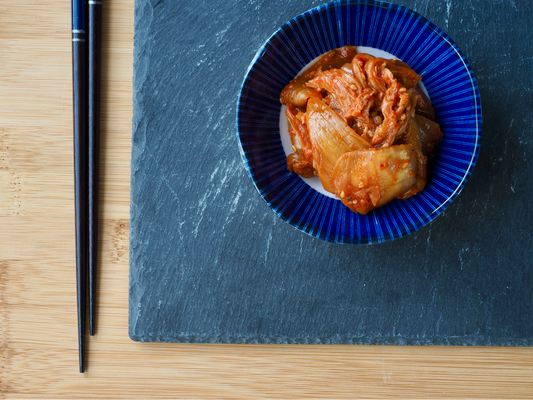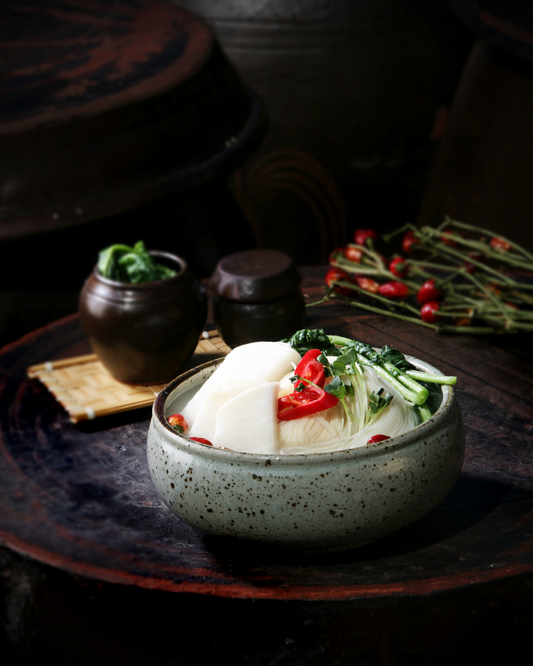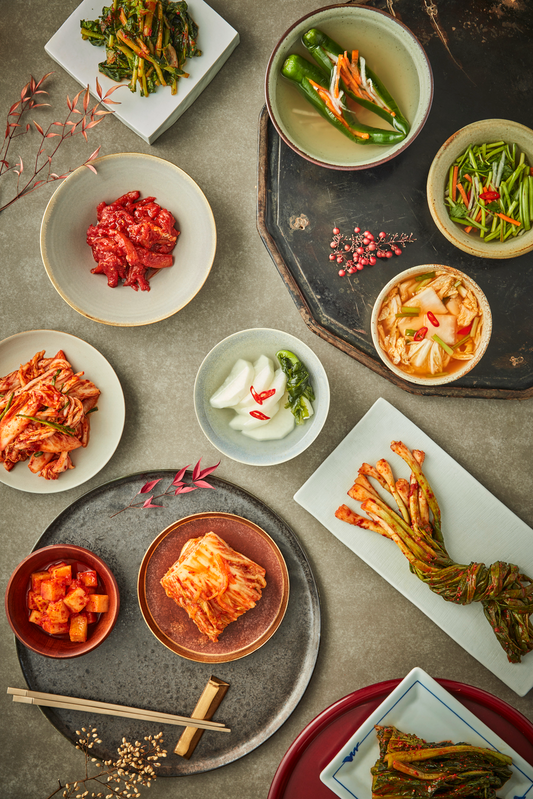Are you ready to try a tasty and healthy twist on traditional kimchi? Bok choy kimchi is a spicy, tangy Korean dish you can make at home. It's quick and easy, perfect for enjoying kimchi's health benefits with a new flavor.
Bok choy makes a great base for this kimchi. It's coated in a sauce with onion, apple, garlic, ginger, and more. This mix of sweet, salty, and spicy flavors is both Whole and vegan-friendly. Plus, you can find all the ingredients at most Asian markets.
Bok choy kimchi is not just delicious; it's also good for you. It's full of probiotics, which help with digestion and boost your immune system. Each serving has only 40 calories, 2g of protein, and lots of vitamins A and C.
You can enjoy bok choy kimchi as a side dish or in recipes like Bok Choy Kimchi Pancake. It's a versatile and nutritious addition to any meal. So, let's explore how to make this tasty kimchi at home!
Key Takeaways:
- Bok choy kimchi is a quick and easy-to-make kimchi variant that doesn't require fermentation.
- This kimchi recipe is Whole30 and vegan-friendly, using affordable and accessible ingredients.
- Each serving of bok choy kimchi is low in calories but rich in probiotics, vitamins, and minerals.
- Bok choy kimchi aids digestion, boosts immunity, and supports overall gut health.
- This versatile kimchi can be enjoyed as a side dish or incorporated into various recipes for added flavor and nutrition.

Definition of Bok Choy
Bok choy is a Chinese cabbage loved worldwide, including in Korean dishes. It has dark green leaves and white stalks. These offer a mild, sweet taste and a crisp feel. Baby bok choy, being smaller and tender, is especially liked for its delicate flavor and fast cooking.
Basic Explanation of Bok Choy
Bok choy belongs to the Brassica family, like broccoli and kale. It's available all year, but peaks in winter. You can find it in Asian markets and more in regular supermarkets. It's packed with vitamins A, C, and K, and minerals like calcium and potassium, making it healthy.
Differences Between Bok Choy Kimchi and Other Types of Kimchi
Bok choy kimchi is a twist on traditional Korean kimchi, made with napa cabbage. Unlike napa cabbage kimchi, bok choy kimchi is lightly salted, or geotjeori. This makes it fresh and mild, but it lasts only 2-3 weeks in the fridge.
The Cultural Background and Unique Features of Bok Choy in Korean Cuisine
In Korean food, bok choy kimchi is a favorite side dish. It's crisp and mildly spicy, adding freshness to meals. Baby bok choy's tender leaves and stems are perfect for quick pickling. This shows Korean cooking's creativity and tradition, welcoming new ingredients while keeping core flavors.

Ingredients and Health Benefits
Bok choy kimchi is a tasty twist on traditional kimchi. It also has many health benefits. The ingredients like bok choy, gochugaru, garlic, and ginger are full of nutrients.
Bok Choy: A Nutritional Powerhouse
Bok choy is the main ingredient in this recipe. It's low in calories but rich in vitamins and minerals. A 1-cup serving has only 9 calories but lots of vitamin A, C, K, and calcium.
These nutrients help keep bones, skin, and vision healthy. They also boost the immune system.
Probiotics: Boosting Gut Health and Immunity
Kimchi is known for its probiotics. These beneficial bacteria help with digestion and gut health. Eating kimchi can improve the gut microbiome and strengthen the immune system.
It also lowers inflammation in the body. This is good during infections.
Gochugaru and Capsaicin: Anti-Inflammatory and Metabolism-Boosting Properties
Gochugaru adds heat and flavor to bok choy kimchi. It also has health benefits. The capsaicin in gochugaru fights inflammation and boosts metabolism.
This can help with weight management.
Garlic and Ginger: Antioxidant and Immune-Boosting Effects
Garlic and ginger add flavor to bok choy kimchi. They also have health benefits. Garlic has compounds that fight inflammation and support the immune system.
Ginger has anti-inflammatory and antioxidant effects. It helps protect against oxidative stress and supports the immune system.
Eating bok choy kimchi can be good for your health. It's low in calories and high in fiber. It's a great choice for a balanced diet.

Recipe
Making bok choy kimchi at home is easy and rewarding. It adds a unique twist to traditional kimchi. With a few ingredients and patience, you can make a tasty side dish for any meal.
List of ingredients
To make bok choy kimchi, you'll need:
- 1 pound baby bok choy, washed and sliced into bite-sized pieces
- 1 tablespoon sea salt or kosher salt
- 1/2 onion, diced
- 1/2 apple, peeled and diced
- 3 cloves garlic, minced
- 1-inch piece of ginger, peeled and grated
- 2 tablespoons fish sauce (or soy sauce/coconut aminos for vegan version)
- 1 tablespoon rice vinegar
- 1/4 cup water
- 2-3 tablespoons gochugaru (Korean red pepper flakes), adjusted to taste
- 1 teaspoon sesame seeds (optional)
Cooking process
To prepare the bok choy kimchi, follow these steps:
- Place the sliced bok choy in a large bowl and sprinkle with salt. Gently massage the salt into the bok choy until it begins to soften and release water. Let it sit for 30 minutes to an hour.
- In a blender or food processor, combine the onion, apple, garlic, ginger, fish sauce (or soy sauce/coconut aminos), rice vinegar, and water. Blend until smooth to create the kimchi sauce.
- Drain the salted bok choy and rinse it under cold water. Gently squeeze out excess water and place the bok choy back in the bowl.
- Pour the kimchi sauce over the bok choy and add the gochugaru. Mix thoroughly, ensuring that the bok choy is evenly coated with the sauce and spices.
- Taste the mixture and adjust the seasoning as needed, adding more salt, gochugaru, or other ingredients to suit your preferences.
- Transfer the bok choy kimchi to a clean glass jar or airtight container, pressing down to remove any air pockets. Sprinkle sesame seeds on top, if desired.
Storage method
To store your homemade bok choy kimchi, follow these guidelines:
- Place the jar or container in the refrigerator, where it will keep for up to 3 weeks.
- For a quick fermentation, you can leave the kimchi at room temperature for 24 hours before refrigerating. However, be aware that longer fermentation may result in a more bitter taste and softer texture due to the delicate nature of bok choy compared to heartier vegetables like napa cabbage.
- Always use a clean utensil when handling the kimchi to prevent contamination and ensure proper storage.
By following this recipe and storage guidelines, you can enjoy the unique and satisfying flavors of homemade bok choy kimchi as a side dish or ingredient in various recipes.
Tips + Cooking Ideas
Bok choy kimchi is super versatile. You can serve it as a side dish or add it to your favorite recipes. It brings a tangy, spicy flavor to any meal.

Various Dishes and Uses for Bok Choy Kimchi
Enjoy bok choy kimchi as a side with Korean meals like rice and grilled meats. It's perfect for a traditional Korean spread. You can also top bibimbap with it for a flavorful twist.
For a tasty snack, mix chopped kimchi into pancake batter and fry until crispy. These kimchi pancakes are a hit! Or, use it in Asian-inspired tacos for a unique flavor.
Recommended Foods to Pair with Bok Choy Kimchi
Bok choy kimchi is great in noodle dishes like ramen or stir-fries. It adds a spicy kick that complements other ingredients. Feel free to add it to your favorite recipes for endless possibilities.
It's amazing in savory pancakes, rice bowls, cornbread casserole, and even cocktails. Pair it with cucumber, sausage, fennel seeds, red wine, short ribs, mozzarella, cheddar cheese, chicken, tofu, pork belly, beef, shrimp, collards, dumplings, and bacon for exciting flavors. Bok choy kimchi is a fantastic ingredient to have in your kitchen.
FAQ
What is bok choy kimchi?
Bok choy kimchi is a tasty Korean side dish. It's made with baby bok choy, a flavorful sauce, and seasonings. It's a geotjeori style kimchi, which means it's lightly salted and ready to eat right away.
What are the health benefits of bok choy kimchi?
Bok choy kimchi is packed with vitamins A and C, potassium, and calcium. The fermentation process adds probiotics that help your gut health and digestion. The gochugaru, garlic, and ginger in it also boost your immune system and fight inflammation.
How do you make bok choy kimchi?
First, slice and salt the baby bok choy to soften it. Then, blend the sauce ingredients like onion, apple, garlic, ginger, fish sauce (or vegan alternatives), rice vinegar, water, and gochugaru. Mix the sauce with the bok choy, taste, and adjust the seasoning as needed.
How long does bok choy kimchi last in the refrigerator?
You can store bok choy kimchi in a glass jar or airtight container in the fridge for up to 3 weeks. For a quick version, ferment it for 24 hours at room temperature. But, longer fermentation might make it bitter and mushy.
What dishes can I make with bok choy kimchi?
Bok choy kimchi is great with many dishes. Enjoy it with Korean meals, add it to bibimbap, or mix it into pancake batter. You can also use it as a filling for Asian tacos or add it to noodle dishes and stir-fries for a spicy kick.
Is bok choy kimchi vegan-friendly?
Yes, bok choy kimchi can be vegan by using soy sauce or coconut aminos instead of fish sauce. The rest of the ingredients, like baby bok choy, onion, apple, garlic, ginger, rice vinegar, water, and gochugaru, are all plant-based.
What is the difference between bok choy kimchi and traditional napa cabbage kimchi?
Bok choy kimchi is different from traditional napa cabbage kimchi because it's a geotjeori style. This means it's lightly salted and eaten right away, but it lasts only 2-3 weeks. Bok choy has a milder flavor and a tender texture compared to napa cabbage.








